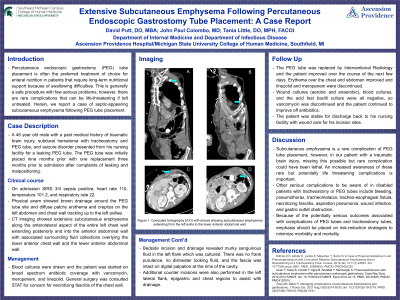Monday Poster Session
Category: Stomach
P3384 - Extensive Subcutaneous Emphysema Following Percutaneous Endoscopic Gastrostomy Tube Placement: A Case Report
Monday, October 28, 2024
10:30 AM - 4:00 PM ET
Location: Exhibit Hall E

Has Audio
- DP
David Putt, DO, MBA
Ascension Providence Hospital
Southfield, MI
Presenting Author(s)
David Putt, DO, MBA, John Paul Colombo, MD, Tania Little, MD
Ascension Providence Hospital, Southfield, MI
Introduction: Percutaneous endoscopic gastrostomy (PEG) tube placement is often the preferred treatment of choice for enteral nutrition in patients that require long-term nutritional support because of swallowing difficulties. This is generally a safe procedure with few serious problems, however, there are rare complications that can be life-threatening if left untreated. Herein, we report a case of septic-appearing subcutaneous emphysema following PEG tube placement in a patient with a traumatic brain injury.
Case Description/Methods: A 48 year old male with a past medical history of traumatic brain injury, subdural hematoma with tracheostomy and PEG tube presented from his nursing facility for a leaking PEG tube. On admission the patient was SIRS 3/4 sepsis positive. Physical exam was positive for brownish drainage around the PEG tube site and diffuse patchy erythema and crepitus on the left abdomen and chest wall tracking up to the left axillae. CT imaging showed extensive subcutaneous emphysema and associated surrounding fluid collections overlying the anterior chest wall. Blood cultures were drawn and the patient was started on broad spectrum antibiotics. A bedside incision and drainage revealed murky sanguinous fluid in the left flank which was cultured. There was no frank purulence, no dishwater looking fluid, and the fascia was intact on digital palpation at the rims of the cavity. The PEG tube was replaced by Interventional Radiology and the patient improved over the course of the next few days. Wound cultures (aerobic and anaerobic), blood cultures, and the acid fast bacilli culture were all negative, so antibiotics were discontinued. The patient was stable for discharge back to his nursing facility with wound care for his incision sites.
Discussion: Subcutaneous emphysema is a rare complication of PEG tube placement, however, in our patient with a traumatic brain injury, missing this possible but rare complication could have been lethal. An increased awareness of these rare but potentially life threatening complications is important. Other serious complications to be aware of in disabled patients with tracheostomy or PEG tubes include bleeding, pneumothorax, tracheomalacia, tracheo-esophageal fistula, necrotizing fasciitis, aspiration pneumonia, wound infection, and gastric outlet obstruction. Because of the potentially serious outcomes associated with complications of PEG tubes and tracheostomy tubes, emphasis should be placed on risk-reduction strategies to minimize morbidity and mortality.
Disclosures:
David Putt, DO, MBA, John Paul Colombo, MD, Tania Little, MD. P3384 - Extensive Subcutaneous Emphysema Following Percutaneous Endoscopic Gastrostomy Tube Placement: A Case Report, ACG 2024 Annual Scientific Meeting Abstracts. Philadelphia, PA: American College of Gastroenterology.
Ascension Providence Hospital, Southfield, MI
Introduction: Percutaneous endoscopic gastrostomy (PEG) tube placement is often the preferred treatment of choice for enteral nutrition in patients that require long-term nutritional support because of swallowing difficulties. This is generally a safe procedure with few serious problems, however, there are rare complications that can be life-threatening if left untreated. Herein, we report a case of septic-appearing subcutaneous emphysema following PEG tube placement in a patient with a traumatic brain injury.
Case Description/Methods: A 48 year old male with a past medical history of traumatic brain injury, subdural hematoma with tracheostomy and PEG tube presented from his nursing facility for a leaking PEG tube. On admission the patient was SIRS 3/4 sepsis positive. Physical exam was positive for brownish drainage around the PEG tube site and diffuse patchy erythema and crepitus on the left abdomen and chest wall tracking up to the left axillae. CT imaging showed extensive subcutaneous emphysema and associated surrounding fluid collections overlying the anterior chest wall. Blood cultures were drawn and the patient was started on broad spectrum antibiotics. A bedside incision and drainage revealed murky sanguinous fluid in the left flank which was cultured. There was no frank purulence, no dishwater looking fluid, and the fascia was intact on digital palpation at the rims of the cavity. The PEG tube was replaced by Interventional Radiology and the patient improved over the course of the next few days. Wound cultures (aerobic and anaerobic), blood cultures, and the acid fast bacilli culture were all negative, so antibiotics were discontinued. The patient was stable for discharge back to his nursing facility with wound care for his incision sites.
Discussion: Subcutaneous emphysema is a rare complication of PEG tube placement, however, in our patient with a traumatic brain injury, missing this possible but rare complication could have been lethal. An increased awareness of these rare but potentially life threatening complications is important. Other serious complications to be aware of in disabled patients with tracheostomy or PEG tubes include bleeding, pneumothorax, tracheomalacia, tracheo-esophageal fistula, necrotizing fasciitis, aspiration pneumonia, wound infection, and gastric outlet obstruction. Because of the potentially serious outcomes associated with complications of PEG tubes and tracheostomy tubes, emphasis should be placed on risk-reduction strategies to minimize morbidity and mortality.
Disclosures:
David Putt indicated no relevant financial relationships.
John Paul Colombo indicated no relevant financial relationships.
Tania Little indicated no relevant financial relationships.
David Putt, DO, MBA, John Paul Colombo, MD, Tania Little, MD. P3384 - Extensive Subcutaneous Emphysema Following Percutaneous Endoscopic Gastrostomy Tube Placement: A Case Report, ACG 2024 Annual Scientific Meeting Abstracts. Philadelphia, PA: American College of Gastroenterology.
